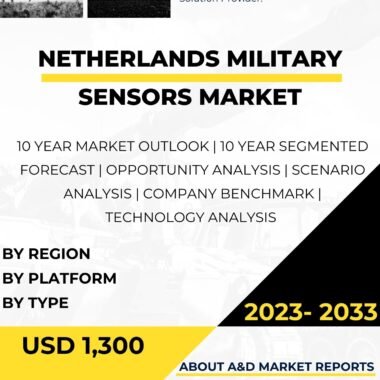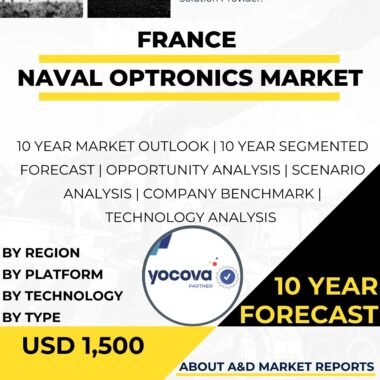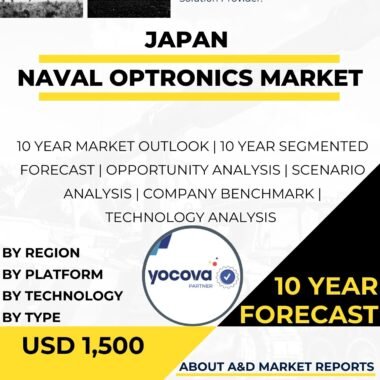Description
The naval optronics market in Malaysia is witnessing steady advancement as the country emphasizes modernization of its naval defense capabilities. Naval optronics refers to the integration of advanced optical and electronic systems designed for maritime surveillance, threat detection, target acquisition, and navigation. In Malaysia, this market is influenced by the nation?s strategic location along critical maritime routes and the increasing need to safeguard its extensive coastline and offshore assets. The demand for optronics stems from the necessity to enhance situational awareness and operational efficiency for its naval fleet, including surface vessels, submarines, and coastal defense units.
Malaysia?s naval modernization initiatives are propelled by regional maritime security challenges, including territorial disputes, piracy, and increasing naval activities by neighboring countries. These factors drive the demand for sophisticated electro-optical and infrared (EO/IR) sensors that enable long-range detection and identification in diverse environmental conditions. EO/IR systems, which form a significant part of naval optronics, provide real-time visual data crucial for early warning, reconnaissance, and precision targeting. Such systems support day-and-night operations and allow the navy to maintain superior maritime domain awareness essential for defensive and offensive operations.
The Malaysian Navy benefits from advanced surveillance systems that combine high-definition cameras, laser rangefinders, and infrared detectors. These systems are often integrated with software-defined video processing technologies that allow for real-time data analysis, automated target recognition, and enhanced image stabilization even in rough sea conditions. The ability to upgrade software algorithms without hardware replacement is particularly valuable, extending the asset lifecycle and ensuring operational readiness.
Surface combatants remain the primary platform driving the naval optronics market in Malaysia. Every new or refitted surface vessel is equipped with multiple stabilized electro-optic directors and secondary sensor arrays to support navigation, fire control, and comprehensive surveillance. These sensor suites contribute significantly to maintaining surface dominance by ensuring targets can be classified and tracked with precision. Additionally, optronic masts and digital periscopes are receiving attention in submarine modernization programs, replacing traditional optical hull penetrations with digital sensor modules that enhance stealth and operational security.
Unmanned maritime platforms are among the fastest-growing segments within Malaysia?s naval optronics sector. The integration of compact EO/IR payloads on autonomous surface and underwater vessels aligns with doctrines focusing on risk reduction and dispersed maritime lethality. With requirements for minimal mast signatures and power-efficient sensors, research and development efforts in Malaysia emphasize lightweight, low-power consumption components such as wafer-bonded readout integrated circuits and advanced thermal management solutions. These innovations enable smaller vessel designs that can carry effective sensor suites, broadening the operational envelope of unmanned naval systems.
The Malaysian naval optronics market is also shaped by collaborative efforts with international defense firms and technology suppliers. These partnerships facilitate technology transfer and localized production, contributing to the development of a self-reliant defense electronics industry within the country. Malaysia?s defense sector encourages joint ventures and alliances with global Original Equipment Manufacturers (OEMs), supporting the assembly and integration of advanced optronic systems tailored to the specific operational requirements of the Malaysian Navy.
Key players in this space include multinational companies offering electro-optic and infrared sensor technologies, as well as specialized firms focusing on software enhancement, autonomous signal processing, and reliability improvements. Malaysian defense procurement emphasizes systems that not only meet high technical standards but also offer adaptability for future upgrades in automated target classification, threat prioritization, and navigation resilience under GPS-denied conditions.
The role of naval optronics extends beyond combat scenarios to support humanitarian missions, search-and-rescue operations, and maritime law enforcement. Night vision and low-light imaging technologies are integral for coastal patrol vessels engaged in anti-piracy and border security operations, particularly in chokepoints and high-traffic sea lanes within Malaysia?s maritime jurisdiction.
Investment in cybersecurity is another critical aspect of Malaysia?s naval optronics infrastructure. Securing communication links and sensor data streams from potential cyberattacks ensures that sensitive operational information remains protected against interception or manipulation. This integration of cyber defense with physical sensor systems reflects the broader trend toward network-centric warfare and sensor-based command and control, which Malaysia is actively pursuing.
The progression of the naval optronics market in Malaysia is reflective of a broader regional trend in the Asia-Pacific, where increased naval expenditure and fleet expansion amplify demand for sophisticated maritime sensor technologies. The country aims to secure its territorial waters and project a credible maritime presence by adopting next-generation optronic solutions that enhance both defensive and offensive capabilities.
In summary, the Malaysian naval optronics market is marked by technological sophistication, strategic partnerships, and a focus on innovation to meet evolving maritime security demands. The integration of high-resolution EO/IR sensors, digital masts, compact payloads for unmanned systems, and software-defined processing capabilities forms the cornerstone of the market?s growth. As regional maritime tensions influence defense priorities, Malaysia?s ongoing efforts to modernize its naval fleet with advanced optronic technologies position it to maintain a robust and responsive maritime defense posture. This evolving market landscape is characterized by a blend of indigenous development and international collaboration aimed at delivering resilient, upgradeable, and multifaceted naval optronics solutions.




